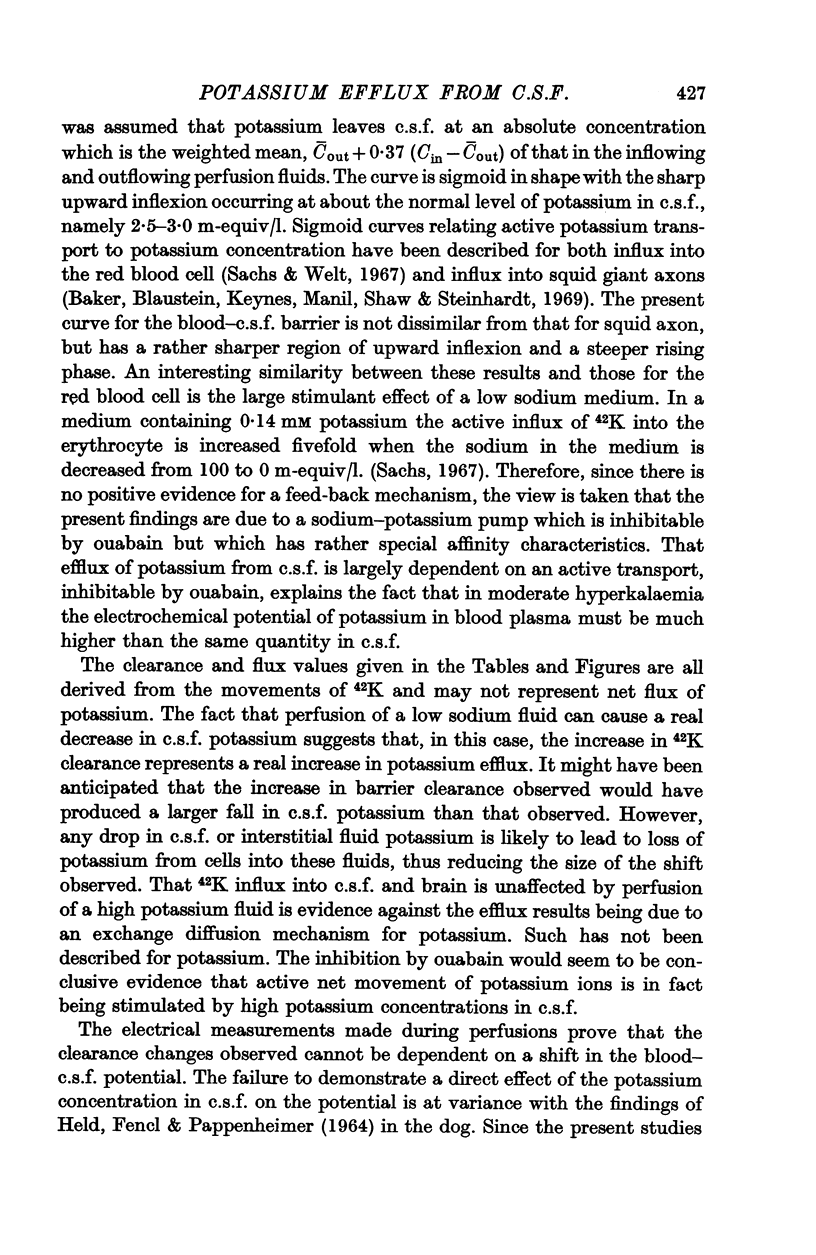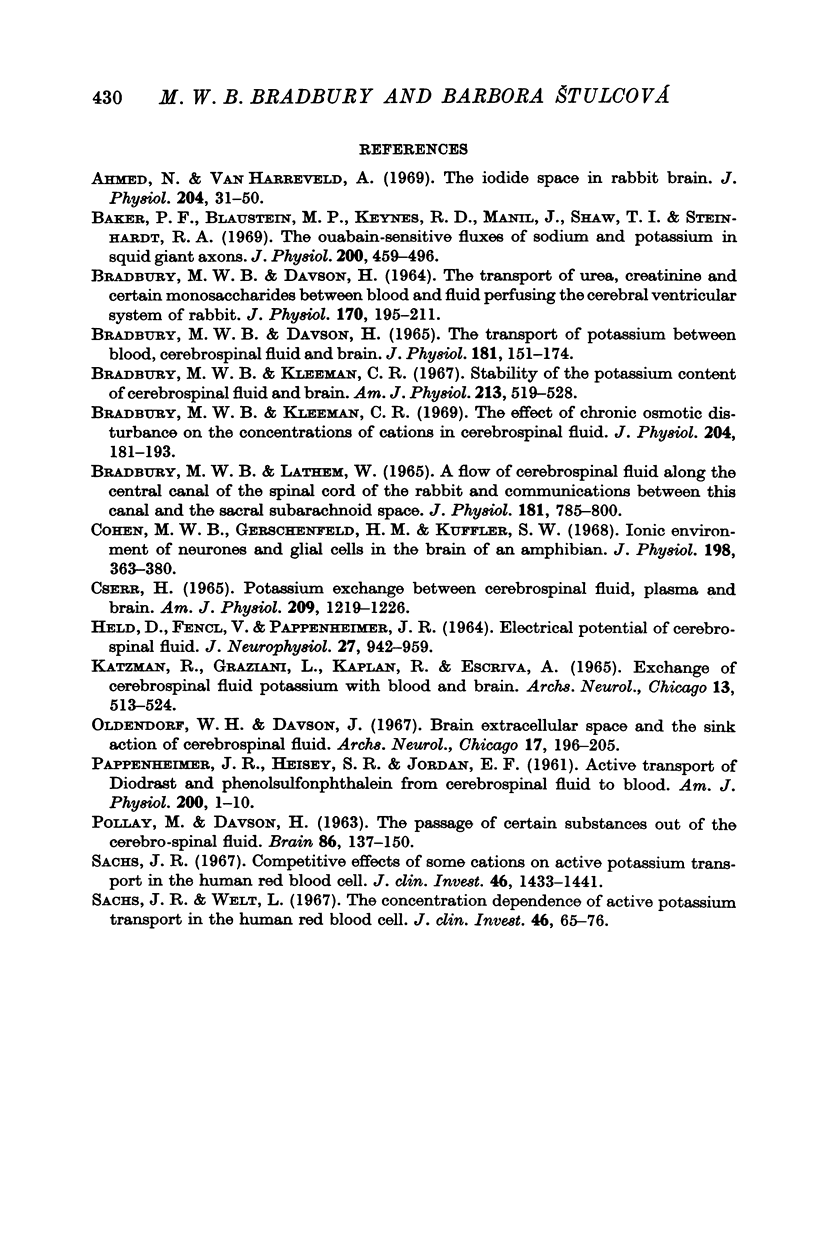Abstract
1. The clearance of 42K from c.s.f. has been separated into two components by means of ventriculo-cisternal perfusion in the rabbit. At 2 hr the largest fraction of radioactivity is recoverable from brain. A smaller fraction passes into the bloodstream and this loss can be expressed as a barrier clearance.
2. The clearance into brain was largely independent of potassium concentrations in the perfusion fluid of 15 m-equiv/l. and below. It was depressed by ouabain, 10-2 mM.
3. The barrier clearance was small, about 9% of the total, when the perfusion fluid contained potassium (1·5 m-equiv/l. or below). Above this concentration it increased steeply reaching 32 μl./min or 37% of the total at 10 m-equiv/l. A similar high barrier clearance was caused by replacing 84% of the sodium in the perfusion fluid with choline. Ouabain, 10-2 mM, abolished the increased barrier clearance due to potassium (10 m-equiv/l.).
4. The clearance of [14C]urea into both brain and blood was unaffected by the potassium concentration in c.s.f. The barrier clearance of [14C]urea was, if anything, increased by 10-2 mM ouabain.
5. Perfusion of the low sodium fluid caused a net loss of potassium from c.s.f.
6. The influx of 42K into c.s.f. from blood was the same, when the perfusion fluid contained potassium (2·9 or 10 m-equiv/l.).
7. The potential between c.s.f. and blood of about 4 mV (c.s.f. positive) was little affected by the potassium or sodium concentration in the perfusion fluid.
8. These observations indicate that the net flux of potassium ions from c.s.f. to blood begins to increase very steeply with the potassium concentration in c.s.f., when the latter is between 2 and 3 m-equiv/l. This relation, taken together with the variation of influx with the potassium concentration in blood plasma, can largely explain the known stability of the potassium concentration in the c.s.f. of the rabbit at 2·8-2·9 m-equiv/l.
9. The increased flux of potassium from c.s.f. at raised concentrations of potassium in this fluid appears to depend on a sodium—potassium pump inhibitable by ouabain.
Full text
PDF















Selected References
These references are in PubMed. This may not be the complete list of references from this article.
- Ahmed N., Van Harreveld A. The iodide space in rabbit brain. J Physiol. 1969 Sep;204(1):31–50. doi: 10.1113/jphysiol.1969.sp008896. [DOI] [PMC free article] [PubMed] [Google Scholar]
- BRADBURY M. W., DAVSON H. THE TRANSPORT OF UREA, CREATININE AND CERTAIN MONOSACCHARIDES BETWEEN BLOOD AND FLUID PERFUSING THE CEREBRAL VENTRICULAR SYSTEM OF RABBITS. J Physiol. 1964 Jan;170:195–211. doi: 10.1113/jphysiol.1964.sp007323. [DOI] [PMC free article] [PubMed] [Google Scholar]
- Baker P. F., Blaustein M. P., Keynes R. D., Manil J., Shaw T. I., Steinhardt R. A. The ouabain-sensitive fluxes of sodium and potassium in squid giant axons. J Physiol. 1969 Feb;200(2):459–496. doi: 10.1113/jphysiol.1969.sp008703. [DOI] [PMC free article] [PubMed] [Google Scholar]
- Bradbury M. W., Davson H. The transport of potassium between blood, cerebrospinal fluid and brain. J Physiol. 1965 Nov;181(1):151–174. doi: 10.1113/jphysiol.1965.sp007752. [DOI] [PMC free article] [PubMed] [Google Scholar]
- Bradbury M. W., Kleeman C. R. Stability of the potassium content of cerebrospinal fluid and brain. Am J Physiol. 1967 Aug;213(2):519–528. doi: 10.1152/ajplegacy.1967.213.2.519. [DOI] [PubMed] [Google Scholar]
- Bradbury M. W., Kleeman C. R. The effect of chronic osmotic disturbance on the concentrations of cations in cerebrospinal fluid. J Physiol. 1969 Sep;204(1):181–193. doi: 10.1113/jphysiol.1969.sp008907. [DOI] [PMC free article] [PubMed] [Google Scholar]
- Bradbury M. W., Lathem W. A flow of cerebrospinal fluid along the central canal of the spinal cord of the rabbit and communications between this canal and the sacral subarachnoid space. J Physiol. 1965 Dec;181(4):785–800. doi: 10.1113/jphysiol.1965.sp007797. [DOI] [PMC free article] [PubMed] [Google Scholar]
- Cohen M. W., Gerschenfeld H. M., Kuffler S. W. Ionic environment of neurones and glial cells in the brain of an amphibian. J Physiol. 1968 Jul;197(2):363–380. doi: 10.1113/jphysiol.1968.sp008564. [DOI] [PMC free article] [PubMed] [Google Scholar]
- Cserr H. Potassium exchange between cerebrospinal fluid, plasma, and brain. Am J Physiol. 1965 Dec;209(6):1219–1226. doi: 10.1152/ajplegacy.1965.209.6.1219. [DOI] [PubMed] [Google Scholar]
- HELD D., FENCL V., PAPPENHEIMER J. R. ELECTRICAL POTENTIAL OF CEREBROSPINAL FLUID. J Neurophysiol. 1964 Sep;27:942–959. doi: 10.1152/jn.1964.27.5.942. [DOI] [PubMed] [Google Scholar]
- Katzman R., Graziani L., Kaplan R., Escriva A. Exchange of cerebrospinal fluid potassium with blood and brain. Study in normal and Ouabain perfused cats. Arch Neurol. 1965 Nov;13(5):513–524. doi: 10.1001/archneur.1965.00470050061007. [DOI] [PubMed] [Google Scholar]
- Oldendorf W. H., Davson H. Brain extracellular space and the sink action of cerebrospinal fluid. Measurement of rabbit brain extracellular space using sucrose labeled with carbon 14. Arch Neurol. 1967 Aug;17(2):196–205. doi: 10.1001/archneur.1967.00470260086010. [DOI] [PubMed] [Google Scholar]
- PAPPENHEIMER J. R., HEISEY S. R., JORDAN E. F. Active transport of Diodrast and phenolsulfonphthalein from cerebrospinal fluid to blood. Am J Physiol. 1961 Jan;200:1–10. doi: 10.1152/ajplegacy.1961.200.1.1. [DOI] [PubMed] [Google Scholar]
- POLLAY M., DAVSON H. The passage of certain substances out of the cerebrosphinal fluid. Brain. 1963 Mar;86:137–150. doi: 10.1093/brain/86.1.137. [DOI] [PubMed] [Google Scholar]
- Sachs J. R. Competitive effects of some cations on active potassium transport in the human red blood cell. J Clin Invest. 1967 Sep;46(9):1433–1441. doi: 10.1172/JCI105635. [DOI] [PMC free article] [PubMed] [Google Scholar]
- Sachs J. R., Welt L. G. The concentration dependence of active potassium transport in the human red blood cell. J Clin Invest. 1967 Jan;46(1):65–76. doi: 10.1172/JCI105512. [DOI] [PMC free article] [PubMed] [Google Scholar]


